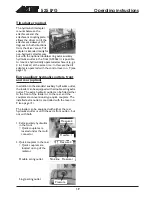
Service and maintenance instructions
30
525 LPG
14. Function and calibration of load sensor
The load sensor must be calibrated in case one adds
or removes more than two AVANT rear weights (+/-
65 kg) on the machine. Calibrating happens as follows:
1. Mount the amount of rear weights with which you
are going to use the loader.
2. Remove the engine cover plate and the lower left
side rear cover plate.
3. Lift something so heavy with the loader that the
rear wheels lift off the ground.
4. Open the screw pointed by the arrows (see picture)
with two 13 mm keys. As the two steel strips come
in contact, tighten the screw.
5. Lower the rear wheels back to the ground and
mount the cover plates.
6. Check function of the load sensor.
NOTICE:
The rear of the loader can not be lifted
with a jack in order to do the calibration. The rear
wheels must be lifted by using the loader boom in
order that the adjustment can be done correctly.
15. Change of LPG system pre filter
The pre filter of LPG system must be changed every
200 hours, see page 31. If composite or steel gas
bottle is being used, the filter must be changed more
frequently.
16.-29. Service, engine
AVANT 525LPG is equipped with a Kubota LPG engine
(see technical specification sheet for the engine type).
Service and maintenance instructions for the engine
can be found in the Kubota Operators Manual supplied
with the loader.
Fuse box
The fuse box is located on the right
side of the loader boom, seen from
drivers seat.
Fuses can be checked by first lifting
the boom so that the fuse box can
easily be reached. Remember to use
the service support.
The list on the right shows the location
and function of each fuse in the fuse
box.
If the engine does not run and the
boom cannot be lifted, the fuses can
be checked after removing the right
side cover plate.
The red indicator no. 18 on the
dashboard indicates blown hydraulic
oil cooler fan fuse. If the indicator is
lit, check the 25A fuse of the oil cooler
fan. Contact Avant service if necessary.
Jump start and auxiliary power
The engine can be started with auxiliary power if
necessary, by using appropriate (strong enough) jump
start cables. Connect first one end of the positive
cable to the positive (+) post of the dead battery.
Then connect the other end of the positive jumper
cable to the positive (+) post of the charged battery.
Connect one end of the negative jumper cable to the
negative (-) post of the charged battery. Then connect
the other end of the negative jumper cable to a solid,
non-paint coated metal part of the engine of the dead
loader, as far from the dead battery as possible.
Read Operators Manual of the vehicle that
is giving auxiliary power, in order to make
sure that the vehicle suited for that. The
vehicle can get damaged when giving auxiliary
starting power.
Safety instructions when handling the battery
Battery contains corrosive sulfuric acid.
Avoid contact with skin or clothes. If electrolyte
gets on your skin or clothes, flush with a lot of water.
In case of contact with eyes, flush with a lot of water
for at least 15 minutes and consult a doctor immediately.
When charging the battery gives off potentially explosive
gases do not smoke when handling the battery.
In order to avoid spark emissions always disconnect
the negative (-) cable first and connect it last.
Before connecting the battery cables make sure
that the polarity is correct: faulty connection will
seriously damage the electric system of the engine.





















